Champagne Pascal Lejeune’s Terroir Fundamentals: Preserving Place’s Details in Single Parcel, Single Village And Back to The Bigger Picture.
Join Us for Saturday Sips: Champagne Pascal Lejeune
Come as you are; come any time that’s convenient for you during our business hours to sample selection from this week’s selections. Our staff will be on hand to discuss nuances of the wines, the terroirs reflected, and the producers.
The permutations of Champagne are as varied as its terroir, but in the exploration, facts keep popping up in triads: In the favored grapes (Pinot Noir, Chardonnay, Meunier), in styles (Blanc de Noirs, Blanc de Blancs, Rosé) and in varying level, in dosage (Brut, Sec and Doux). There are strata in each of these categories, of course, but you get the picture.
Now the trio of Pascal, Sandrine and Thibaut Lejeune (a dad, mom and son team) from the Coteaux Sud d’Épernay, are excelling in the production wines from three categories: Village level, lieu-dit (monoparcellaire) level and a cépage made of grapes from the three villages where they grow fruit, Épernay, Moussy and Vinay.
A new addition to our Champagne portfolio, Champagne Pascal Lejeune is a small grower/bottler whose reputation is as solid as the output is small. These wines represent both a spirit of renewability in an age-old product and some of the most terroir-reflective Champagnes we’ve tasted.
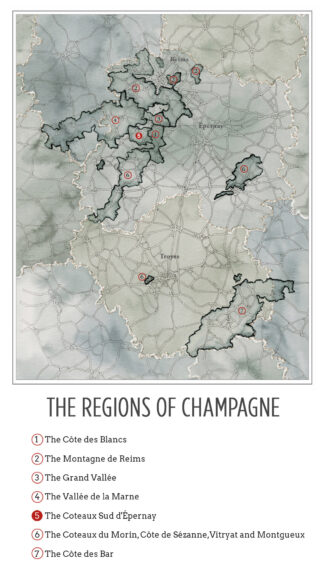
The Coteaux Sud d’Épernay: Middle Grounds
The Reims-based Union de Maisons de Champagne names 17 ‘terroirs’ in Champagne; among them, on the left bank of the Marne river, is Côteaux Sud d’Épernay. As the name suggests, it occupies the slopes (côteaux) south of Épernay. These slopes are formed by three streams (another triad), Le Cubry, Le Darcy, and Le Mancy. Le Cubry empties into the Marne at Épernay, and forms the valley that runs to the southwest and further west to Saint-Martin-d’Ablois. Le Darcy is a tributary of Le Cubry that empties into the latter at Pierry and Le Mancy is a tributary of Le Darcy that empties into it in the northern part of the Mancy commune.
Enough geography? On to grapes! The Coteaux Sud d’Épernay is fairly evenly balanced between Meunier at 46.7% and Chardonnay at 40.9%, with Pinot Noir making up the remainder. Somewhat simplified, it can be said that Chardonnay is most common in Épernay and in the valleys of Le Mancy and Le Darcy in the north and east, while Meunier prevails in the valley of Le Cubry (excluding Épernay) in the center and west.
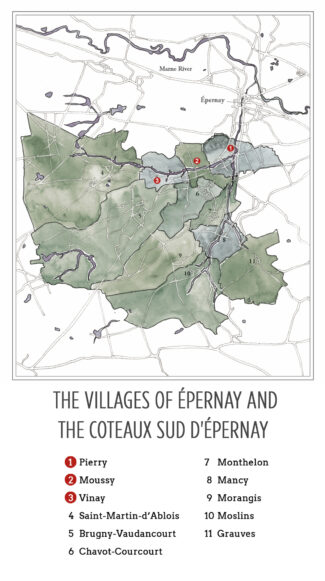
Sandwiched between two powerhouse wine regions (Côte des Blancs and Vallée de la Marne), the Coteaux has an identity removed from either one. Its terroir is different from the clay-heavy soils of the Marne and it lacks the pure chalk that puts the ‘blanc’ in the Côte des Blancs.
In short, these Champagnes are uniquely situated to offer the best of both worlds. As a result, the Coteaux Sud d’Épernay has long fought for recognition as entity unto itself, not necessarily a sub-region of its big brothers on either side.
The current vineyard surface in the Coteaux Sud d’Épernay is a little over 3000 acres distributed among 878 vineyard owners in 11 communes.
Champagne Pascal Lejeune
Beating swords into ploughshares is a Biblical injection that Pascal Lejeune takes literally—he left his career in the military and gave himself to the vine. It didn’t hurt that he fell in love with a Champagne grower’s daughter: Pascal’s wife Sandrine hails from a family that has been growing grapevines in Moussy (where more than half of the vineyard’s grapevines are located) on the south-facing slopes of Épernay since 1910. Originally a side operation, not an essential part of the family’s activities, Sandrine’s great grandfather Edmond played an active part in creating the Moussy cooperative.
In 1995, when Pascal and Sandrine took the reins, their aim was to usher in a new era by enlarging the vineyard area into nearby terroirs, and by enriching the range of offerings via new cuvées: As a brand, Champagne Pascal Lejeune was born.
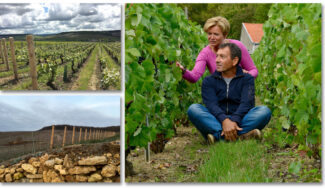
Pascal and Sandrine Lejeune, Champagne Pascal Lejeune
Says Pascal, “I believe I have a responsibility and commit myself collectively to our business and our terroir in order to perpetuate and monitor developments for our children and future generations. This requires a sincere respect for people, nature, our vines, our soils, and careful work in order to obtain quality grapes. To offer you the best that nature offers us, our vintages are very different, there is something for every occasion and taste… Nature does things well!”
This commitment to nature has been proven out over the past 17 years; Lejeune was one of the first producers in Champagne to plant specially-selected grass species between vine rows. Manual techniques are used for pruning, trellising and debudding. “The benefits of this special care can be observed,” says Sandrine. “Biodiversity is maintained, the soils are protected, the erosion is limited, and as the grapevine roots develop, the phytosanitary products have been significantly reduced.
Pascal adds: “Our aim is to give our soils the utmost respect in order to express the organoleptic qualities with authenticity and reveal the subtlety of our champagne. The culmination of these special treatments is, strictly speaking, the grape harvest, which is carried out entirely by hand, reflecting an entire year’s labor of love.”
Pascal and Sandrine are happy with the latest addition to their team, their son Thibaut, now a fifth-generation wine-grower, who joined the family business in 2015. Having completed his oenology and BAC qualification, he shares his father’s passion for grapevines and brings a fresh perspective to the family adventure, and offers a perspective on what he has taken on:
“Our three grape varieties spread out across a mosaic of 42 plots, 64% of our vines are Meunier. Otherwise, Chardonnay and Pinot Noir represent respectively 25% and 11% of the whole vineyard.”
Single-Village Expression: The Stony Soils of Premier Cru ‘Pierry’
The Premier Cru village of Pierry is located immediately to the south of Épernay at the foot of southeast-facing slopes where the vineyards are located. The stream Le Cubry, which forms the valley runs just below the village and continues to the west, emptying into the Marne River at Épernay. Within Pierry, single vineyard sites include Cantuel, Les Chevernets, Les Gayères, Les Gouttes d’Or, Les Noues, Les Porgeons, Les Rouges Fosses, and Les Tartières.
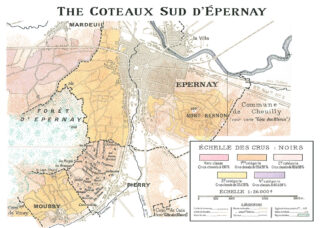
In the now-defunct ‘échelles des crus’ system, Pierry’s former rating of 90% makes it a Premier Cru village, the only commune in the Coteaux Sud d’Épernay to be so classified. (Its three neighbouring communes in the same area were rated 88%.) The terroir explains it, and a local saying is, “Pierry est Pierreux…” Pierry is stony, dominated by flint and chalk, and this minerality carries through to the wine.
Pierry’s current vineyard surface is 270 acres; half Meunier, 32% Chardonnay and 18% Pinot Noir. There are 125 vineyard owners in the commune.
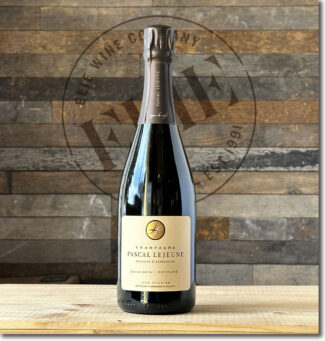 nv Champagne Pascal Lejeune ‘Figure de Style N°4 – OXYMORE’ Brut ($52)
nv Champagne Pascal Lejeune ‘Figure de Style N°4 – OXYMORE’ Brut ($52)
100% Meunier, 40% from the 2019 harvest, 60% reserve wine from 2018; the wine undergoes partial malolactic and 30% barrel ages with regular lees stirring. Dosage is to Brut level; 8g/l. The wine is plump and bold with rich notes of raspberry and stone fruit underlined by cassia and clove, all characteristics of the Meunier grape. 1255 bottles made. Disgorged February 2023.
Chardonnay in Pierry
Less than 30% of Champagne’s 84,000 low, densely-planted acres are Chardonnay, the grape that lords of Burgundian white wine. In cool climates north of Burgundy, however, Chardonnay demands well-favored sites and thrives best on the south- and east-facing chalky slopes of the Côte des Blancs south of Épernay.
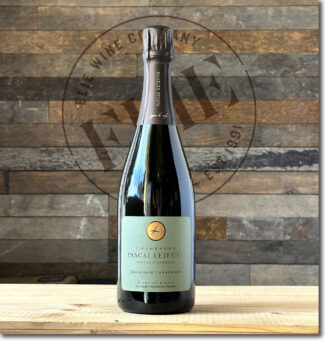 nv Champagne Pascal Lejeune ‘Figure de Style N°2 – ANAPHORE’ Blanc de Blancs Extra-Brut ($56)
nv Champagne Pascal Lejeune ‘Figure de Style N°2 – ANAPHORE’ Blanc de Blancs Extra-Brut ($56)
100% Chardonnay, all from the 2019 harvest; the wine ages in 30% oak barrels for ten months with regular stirring of lees. Dosage is to the level of Extra Brut, 4g/l, using homemade liquor distilled from the three grape varieties used in Champagne. The wine displays complex aromas of lime, sweet Meyer lemon and golden apple. 1235 bottles made. Disgorged February 2023.
Site-Specific ‘Parcellaire’: Village Vinay’s Lieu-dit ‘Les Longs Martins’
The vineyards of Vinay in the Vallée de la Marne, are located both on the slope southwest of Épernay formed by the valley of the stream Le Cubry, and also, in part, below the slope. The vineyards face south-south east, and Meunier is the most common grape variety found. The vineyards are continuous with those in Moussy and Saint-Martin-d’Ablois. The 365 acres are owned by 102 individual ‘exploitants.’
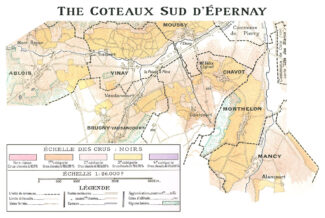
A ‘parcel’ is site-specific, synonymous with ‘lieu-dit’ as used in Burgundy—a named group of exceptionally emblematic vine. It is estimated that there are 84,000 of these named parcels throughout Champagne. ‘Les Longs Martins’ is one.
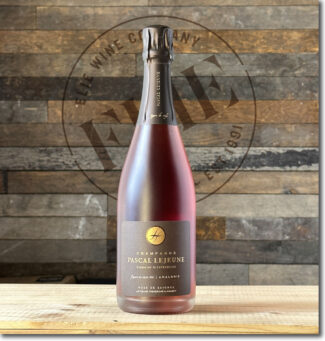 nv Champagne Pascal Lejeune ‘Figure de Style N°6 – ANALOGIE’ Rosé de Saignée Zéro Dosage ($74)
nv Champagne Pascal Lejeune ‘Figure de Style N°6 – ANALOGIE’ Rosé de Saignée Zéro Dosage ($74)
From the organic lieu-dit ‘Les Longs Martins’, this saignée is 100% Pinot Noir from vines that average 25 years old grown in clay, silt, sand and marne limestone. Maceration lasted ten hours, and no malolactic fermentation occurred, leaving the crisp acids intact along with notes of brioche, sweet pastry, vanilla, ripe forest berries and raspberry coulis. Only 638 bottles made. Disgorged December 2022.
The Bigger Picture: Villages Vinay, Moussy and Épernay
Of the 18 communes in the canton ‘Épernay-2’, the triad that produces grapes for Style N°1 each brings its own special spice to the party.
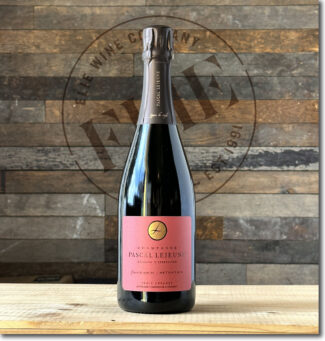 nv Champagne Pascal Lejeune ‘Figure de Style N°1 – METONYMIE’ Extra-Brut ($44)
nv Champagne Pascal Lejeune ‘Figure de Style N°1 – METONYMIE’ Extra-Brut ($44)
59% Pinot Meunier, 32% Chardonnay, 9% Pinot noir from vines that average thirty years old and grown on a south-southeast exposure. 39% of the harvest in this wine came from 2019, the rest from 2018; malolactic only touches the 2018. These grapes originate in the three communes of Vinay, Moussy and Épernay and provide beautifully focused aromas of apple, caramel, stones and minerals. 13,785 bottles made. Disgorged December 2022.
Notebook ….
Single Harvest vs. Vintage
In France, under Appellation d’Origine Contrôlée (AOC) rules, vintage Champagnes must be aged for three years—more than twice the required aging time for NV Champagne. The additional years on the yeast is said to add complexity and texture to the finished wine, and the price commanded by Vintage Champagne may in part be accounted for by the cellar space the wine takes up while aging.
On the other hand, a Champagne maker might prefer to release wine from a single vintage without the aging requirement; the freshness inherent in non-vintage Champagnes is one of its effervescent highlights. In this case, the wine label may announce the year, but the Champagne itself is referred to as ‘Single Harvest’ rather than ‘Vintage’.
Drawing the Boundaries of the Champagne Region
To be Champagne is to be an aristocrat. Your origins may be humble and your feet may be in the dirt; your hands are scarred from pruning and your back aches from moving barrels. But your head is always in the stars.
As such, the struggle to preserve its identity has been at the heart of Champagne’s self-confidence. Although the Champagne controlled designation of origin (AOC) wasn’t recognized until 1936, defense of the designation by its producers goes back much further. Since the first bubble burst in the first glass of sparkling wine in Hautvillers Abbey, producers in Champagne have maintained that their terroirs are unique to the region and any other wine that bears the name is a pretender to their effervescent throne.
The INAO defines the concept like this: “An AOP area is born of an alliance between the natural environment and human ingenuity. From that alliance comes an AOP product with unique, inimitable characteristics, a product so different that it complements rather than competes with other products, possessing a particular identity that adds further value.”
In 1927, the viticultural boundaries of Champagne were legally defined and split into five wine-producing districts: The Aube, Côte des Blancs, Côte de Sézanne, Montagne de Reims, and Vallée de la Marne. The CIVC (Comité Interprofessionnel du vin de Champagne), formed in 1941, decreed that everyone who wanted to plant vines and grow grapes to be used in the creation of Champagne had to be registered, and if you didn’t register back then, there is no out, even now. Originally, grape growing was not a profitable business and was an afterthought meant to utilize chalky slopes where grain would not grow. As a result, many farmers at that time did not register, and today, a tour along the Route Touristique de Champagne, you’ll come across unregistered fields that lie fallow between two registered vineyards.
… Yet another reason why this tiny slice of northern France, a mere 132 square miles, remains both elite and precious.
- - -
Posted on 2023.07.06 in France, Saturday Sips Review Club, Champagne
Featured Wines
- Notebook: A’Boudt Town
- Saturday Sips Wines
- Saturday Sips Review Club
- The Champagne Society
- Wine-Aid Packages
Wine Regions
Grape Varieties
Aglianico, Albarino, Albarín Blanco, Albarín Tinto, Albillo, Aleatico, Arbanne, Aubun, Barbarossa, barbera, Beaune, Biancu Gentile, bourboulenc, Cabernet Franc, Cabernet Sauvignon, Caino, Caladoc, Calvi, Carcajolu-Neru, Carignan, Chablis, Chardonnay, Chasselas, Clairette, Corvina, Cot, Counoise, Erbamat, Ferrol, Fiano, Frappato, Friulano, Fromenteau, Fumin, Garnacha, Gewurztraminer, Godello, Graciano, Grenache, Grolleau, Groppello, Juan Garcia, Lambrusco, Loureira, Macabeo, Macabou, Malvasia, Malvasia Nera, Marsanne, Marselan, Marzemino, Melon de Bourgogne, Merlot, Mondeuse, Montanaccia, Montepulciano, Morescola, Morescono, Moscatell, Muscadelle, Muscat, Natural, Nero d'Avola, Parellada, Patrimonio, Petit Meslier, Petit Verdot, Pineau d'Aunis, Pinot Auxerrois, Pinot Blanc, Pinot Gris, Pinot Meunier, Pinot Noir, Poulsard, Prieto Picudo, Rondinella, Rousanne, Roussanne, Sangiovese, Sauvignon Blanc, Savignin, Semillon, Souson, Sparkling, Sumoll, Sylvaner, Syrah, Tannat, Tempranillo, Trebbiano, Trebbiano Valtenesi, Treixadura, Trousseau, Ugni Blanc, vaccarèse, Verdicchio, Vermentino, Viognier, Viura, Xarel-loWines & Events by Date
- April 2024
- March 2024
- February 2024
- January 2024
- December 2023
- November 2023
- October 2023
- September 2023
- August 2023
- July 2023
- June 2023
- May 2023
- April 2023
- March 2023
- February 2023
- January 2023
- December 2022
- November 2022
- October 2022
- September 2022
- August 2022
- July 2022
- June 2022
- May 2022
- April 2022
- March 2022
- February 2022
- January 2022
- December 2021
- November 2021
- October 2021
- September 2021
- August 2021
- July 2021
- June 2021
- May 2021
- April 2021
- March 2021
- February 2021
- January 2021
- December 2020
- November 2020
- October 2020
- September 2020
- August 2020
- July 2020
- June 2020
- May 2020
- April 2020
- March 2020
- February 2020
- January 2020
- December 2019
- November 2019
- October 2019
- September 2019
- August 2019
- July 2019
- June 2019
- May 2019
- April 2019
- March 2019
- February 2019
- January 2019
- December 2018
- November 2018
- October 2018
- September 2018
- August 2018
- July 2018
- June 2018
- May 2018
- April 2018
- March 2018
- February 2018
- January 2018
- December 2017
- November 2017
- October 2017
- September 2017
- August 2017
- July 2017
- June 2017
- May 2017
- April 2017
- March 2017
- February 2017
- January 2017
- December 2016
- November 2016
- October 2016
- September 2016
- August 2016
- July 2016
- June 2016
- May 2016
- April 2016
- March 2016
- February 2016
- January 2016
- December 2015
- November 2015
- October 2015
- September 2015
- August 2015
- July 2015
- June 2015
- May 2015
- April 2015
- March 2015
- February 2015
- January 2015
- December 2014
- November 2014
- October 2014
- September 2014
- August 2014
- July 2014
- June 2014
- April 2014
- March 2014
- February 2014
- January 2014
- December 2013
- November 2013
- October 2013
- September 2013
- August 2013
- July 2013
- June 2013
- May 2013
- April 2013
- March 2013
- February 2013
- January 2013
- December 2012
- November 2012
- October 2012
- February 2004
Search



